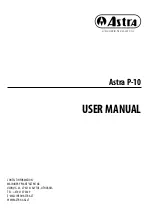
10
Astra P-10 USER MANUAL
Fig. 7
Incorrect installation with two 90° bends.
No
YES
NO
FIG.6
FIG.9
YES
FIG.10
FIG.5
NO
FIG.8
YES
YES
FIG.7
2500 mm
.
max.
H > 4000 mm H > 1500 mm
8
3
4
1
2
9
10
11
5
7
6
12
Ashes accumulate in the 90° bend
Two 90° bends cannot be assembled the
way shown in Fig. 7, because ashes would
quickly obstruct a passage for smoke causing
unexpected problems for draught of the flue.
Fig. 8
Installation with a combined internal/external flue.
Yes
YES
NO
FIG.6
FIG.9
YES
FIG.10
FIG.5
NO
FIG.8
YES
YES
FIG.7
2500 mm
.
max.
H > 4000 mm H > 1500 mm
8
3
4
1
2
9
10
11
5
7
6
12
Insulated chimney tee with
condensation drain pipe
Chimney tee with a cap and a
peephole
Chimney cap for rain
protection
Insulated flue
This type of installation (Fig. 8) does not require an insulated flue for the part inside the house, whereas for the outside part an
insulated tube must be used. A chimney tee with a peephole is installed in the lower part of the flue inside the house. Another
chimney tee is installed in the outside part of the flue making it available for inspection.
Sufficient draught is essential for the efficiency of all chimneys. Draught arises from temperature differences inside and outside of
the chimney, which consequently cause pressure differences.
Weather and geographical conditions such as wind, snow, rain, altitude above sea level, fog, etc., can also have an impact on chimney
draught. Among them, wind is certainly the most important. Wind generally increases draught except in cases of downdraughts,
temperature inversions, or cross draughts caused by tall trees, hills, or buildings in close proximity to the chimney. These situations
can cause the smoke to be pushed back DOWN the chimney.
The installation, placement, and design of the chimney have a direct influence on the stove’s functioning. Any negative influence
of installation can be compensated for by reprogramming the stove controller.This adjustment must be done by qualified service
personnel.











































